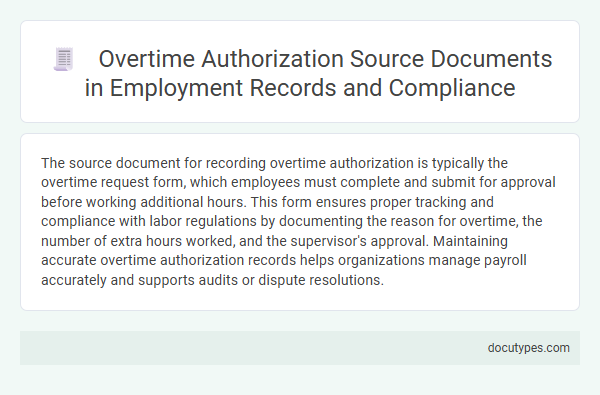The source document for recording overtime authorization is typically the overtime request form, which employees must complete and submit for approval before working additional hours. This form ensures proper tracking and compliance with labor regulations by documenting the reason for overtime, the number of extra hours worked, and the supervisor's approval. Maintaining accurate overtime authorization records helps organizations manage payroll accurately and supports audits or dispute resolutions.
Overview of Overtime Authorization in Employment
| Topic | Details |
|---|---|
| Overtime Authorization | Overtime authorization is an employer-approved permission allowing employees to work beyond their standard work hours. It ensures compliance with labor laws and company policies regarding extra working hours. |
| Purpose of Overtime Authorization | To control and document extra hours worked, manage labor costs, and prevent unauthorized overtime. |
| Source Document for Recording Overtime | Overtime authorization forms or requests serve as the primary source documents. These documents are officially approved before overtime work begins. |
| Key Components of Source Document | Employee details, date and duration of overtime, reason for overtime, manager or supervisor approval, and signature. |
| Record Keeping | The source document is retained for payroll processing, audit, and compliance with labor regulations. |
Key Employment Records for Overtime Tracking
The source document for recording overtime authorization is typically the official overtime request form or timesheet approved by a supervisor. Key employment records for overtime tracking include signed overtime approval forms, employee clock-in and clock-out records, and payroll reports detailing hours worked beyond standard schedules. Maintaining accurate and authorized documentation ensures compliance with labor regulations and supports transparent payroll processing for your overtime hours.
Legal Requirements for Overtime Documentation
The source document for recording overtime authorization is a formal record that validates the approval of extra working hours. Legal requirements mandate this documentation to ensure compliance with labor laws and fair compensation practices.
- Overtime Authorization Form - A standardized form signed by a supervisor confirming approval of additional hours.
- Time Sheets - Official records reflecting hours worked beyond regular schedules, linked to overtime approval.
- Company Policy Compliance - Documentation must adhere to local labor regulations to protect both employer and employee rights.
Types of Overtime Authorization Source Documents
What is the source document for recording overtime authorization? The source document for recording overtime authorization typically includes official forms or digital records approved by management or HR. These documents ensure that all overtime hours worked are properly tracked and authorized.
What are the types of overtime authorization source documents? Common types include written overtime request forms, electronic approval emails, timesheets with manager signatures, and automated system logs. Each type serves as proof that overtime was permitted and documented according to company policy.
Standard Operating Procedures for Overtime Approval
The source document for recording overtime authorization is the official overtime request form, which ensures proper approval before extra hours are worked. Standard operating procedures (SOP) outline the necessary steps for completing and approving this form to maintain compliance and accurate payroll processing.
- Overtime Request Form - Serves as the primary document for employees to formally request additional work hours beyond their regular schedule.
- Manager Approval - Requires a supervisor's signature on the overtime request form to confirm authorization before overtime is performed.
- Timekeeping Records - Are updated based on the approved overtime request form to reflect accurate hours worked and facilitate payroll accuracy.
Following these SOPs ensures consistent documentation and accountability for all overtime worked within an organization.
Best Practices for Maintaining Overtime Records
The source document for recording overtime authorization is typically the overtime authorization form or timesheet approved by a supervisor or manager. This document serves as official proof of approval and details the hours worked beyond regular schedules.
Best practices for maintaining overtime records include ensuring accurate and timely entries to prevent discrepancies and facilitate payroll processing. Storing these documents securely, either digitally or physically, is essential for compliance and future audits.
Compliance Risks and Penalties for Improper Overtime Documentation
The source document for recording overtime authorization typically includes signed approval forms or digital time-tracking entries. Proper documentation ensures compliance with labor laws and protects your organization from legal risks.
Improper overtime documentation can lead to significant penalties and regulatory scrutiny. Maintaining accurate records is essential for audit readiness and workforce transparency.
- Compliance Risks - Failure to document overtime authorization accurately may result in violations of the Fair Labor Standards Act (FLSA).
- Penalties - Employers can face fines, back pay awards, and legal action for improper or missing overtime records.
- Documentation Best Practices - Use standardized forms or electronic systems to capture approved overtime hours and supervisor consent reliably.
Role of Human Resources in Overtime Record Management
The source document for recording overtime authorization is typically the approved overtime request form, which serves as official evidence of employee consent and management approval. This document includes details such as hours worked, dates, and reason for overtime.
The role of Human Resources in overtime record management involves verifying and maintaining these authorization forms to ensure compliance with labor laws and company policies. HR tracks overtime hours for accurate payroll processing and audits. Effective oversight by HR helps prevent disputes related to wage payments and supports transparent record-keeping.
Digital Solutions for Overtime Documentation and Compliance
The source document for recording overtime authorization is typically an official digital timesheet or an electronic overtime request form. These documents serve as primary proof that overtime hours were approved by management.
Digital solutions for overtime documentation streamline the approval process and ensure compliance with labor regulations. Your company can utilize automated workflows to capture, store, and track overtime authorizations securely.
What Is the Source Document for Recording Overtime Authorization? Infographic

